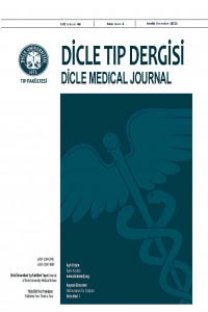Perkütan mitral balon valvüloplasti kısa dönem takip sonuçları: Tek merkez deneyimi
Short-term follow-up results of percutaneous mitral balloon valvuloplasty: A single-center experience
___
- 1. Nishimura RA, Otto CM, Bonow RO, et al. 2014 AHA/ACC guideline for the management of patients with valvular heart disease: a report of the American College of Cardiology/American Heart Association Task Force on Practice Guidelines. J Thoracic Cardiovasc Surg 2014;148:e1-e132.
- 2. Mrozowska E, Krzeminska-Pakula M, Rogowski W, et al. [Atrial fibrillation in mitral valve disease--risk factors]. Polskie Archiwum Medycyny Wewnetrznej 1999;101:45- 53.
- 3. Acarturk E, Usal A, Demir M, et al. Thromboembolism risk in patients with mitral stenosis. Japan Heart J 1997;38:669- 675.
- 4. Walston A, Peter RH, Morris JJ, et al. Clinical implications of pulmonary hypertension in mitral stenosis. Am J Cardiol 1973;32:650-655.
- 5. Inoue K, Owaki T, Nakamura T, et al. Clinical application of transvenous mitral commissurotomy by a new balloon catheter. The Journal of thoracic and cardiovascular surgery 1984;87:394-402.
- 6. Multicenter experience with balloon mitral commissurotomy. NHLBI Balloon Valvuloplasty Registry Report on immediate and 30-day follow-up results. The National Heart, Lung, and Blood Institute Balloon Valvuloplasty Registry Participants. Circulation 1992;85:448-461.
- 7. Korkmaz S, Aksu T, Sasmaz H, et al. [Acute results of percutaneous mitral balloon valvuloplasty]. Turk Kardiyol Dern Ars 2011;39:137-142.
- 8. Chen CR, Cheng TO. Percutaneous balloon mitral valvuloplasty by the Inoue technique: a multicenter study of 4832 patients in China. Am Heart J 1995;129:1197-203.
- 9. Cohen DJ, Kuntz RE, Gordon SP, et al. Predictors of longterm outcome after percutaneous balloon mitral valvuloplasty. N Engl J Med 1992;327:1329-1335.
- 10. Dean LS, Mickel M, Bonan R, et al. Four-year follow-up of patients undergoing percutaneous balloon mitral commissurotomy. A report from the National Heart, Lung, and Blood Institute Balloon Valvuloplasty Registry. J Am Coll Cardiol 1996;28:1452-1457.
- 11. Fawzy ME, Hegazy H, Shoukri M, et al. Long-term clinical and echocardiographic results after successful mitral balloon valvotomy and predictors of long-term outcome. Eur Heart J 2005;26:1647-1652.
- 12. Baumgartner H, Hung J, Bermejo J, et al. Echocardiographic assessment of valve stenosis: EAE/ASE recommendations for clinical practice. J Am Soc Echocardiogr 2009;22:1-23.
- 13. Wilkins GT, Weyman AE, Abascal VM, et al. Percutaneous balloon dilatation of the mitral valve: an analysis of echocardiographic variables related to outcome and the mechanism of dilatation. Br Heart J 1988;60:299-308.
- 14. Song JK, Song JM, Kang DH, et al. Restenosis and adverse clinical events after successful percutaneous mitral valvuloplasty: immediate post-procedural mitral valve area as an important prognosticator. Eur Heart J 2009;30:1254-1262.
- 15. Gurkaynak F, Ozer C, Cehreli S, et al. Perkutan balon mitral valvuloplastinin erken ve kısa dönemlerdeki etkinliğinin noninvaziv olarak değerlendirilmesi. Türkiye Klinikleri Kardiyoloji 1990;3:240-246.
- 16. San M, Bozkurt A, Usal A, ve ark. Perkutan mitral balon valvüloplasti olgularımızın erken dönem sonuçları. Gaziantep Universitesi Tip Fakultesi Dergisi 1998;9:33-37.
- 17. Guray Y, Guray U, Demirkan B, et al. Effect of percutaneous mitral balloon valvuloplasty in various age groups. Turkiye Klinikleri J Cardiovasc Sci 2006;18:103-106.
- ISSN: 1300-2945
- Yayın Aralığı: 4
- Başlangıç: 1963
- Yayıncı: Cahfer GÜLOĞLU
Kolorektal kanserlerde prognostik faktörler
Ahmet TÜRKOĞLU, Ziya ÇETİNKAYA, Mustafa GİRGİN, REFİK AYTEN, BURHAN HAKAN KANAT, Kenan BİNNETOĞLU, Ali AKSU
Ankilozan spondilitli hastalarda komorbit hastalıkların değerlendirmesi
Serda EM, Mehtap BOZKURT, MEHMET ÇAĞLAYAN, PELİN OKTAYOĞLU, Mehmet KARAKOÇ, Kemal NAS
A case of giant ethmoidal osteoma with orbital invasion treated via endonasal endoscopic approach
Eda ŞİMŞEK, ZÜLKÜF KAYA, M. Sıtkı GÖZELER, CÜNEYT KUCUR
Gebelikte akut kolesistit: 21 hastanın retrospektif değerlendirilmesi
Ahmet ŞEKER, Yusuf YÜCEL, Adnan İNCEBIYIK, Orhan GÖZENELİ, NURAY ALTAY, Alpaslan TERZİ, Abdullah ÖZGÖNÜL, ALİ UZUNKÖY
Posttraumatic basal ganglia infarction: A rare complication in a child after mild head injury
Ahmet METE, Duçem METE, SEDAT IŞIKAY
Cem UYSAL, Yaşar TIRAŞÇI, Süleyman SİVRİ, Kasım BULUT, Kenan HASPOLAT, İsmail BOZKURT, Mustafa KORKMAZ, Şeref ŞİMŞEK
Comparison of hair and nail ethyl glucuronide concentrations
Ramazan KARANFİL, Alper KETEN, Cem ZEREN, Emine Nur RİFAİOĞLU, M. Tuğrul GÖKTAŞ
CELALEDDİN SOYALP, Ayşenur DOSTBİL, Mine ÇELİK, ALİ AHISKALIOĞLU, MEHMET AKSOY, İLKER İNCE, Muhammet Ahmet KARAKAYA
Suriye\'deki iç savaşta damar cerrahisi deneyimlerimiz
